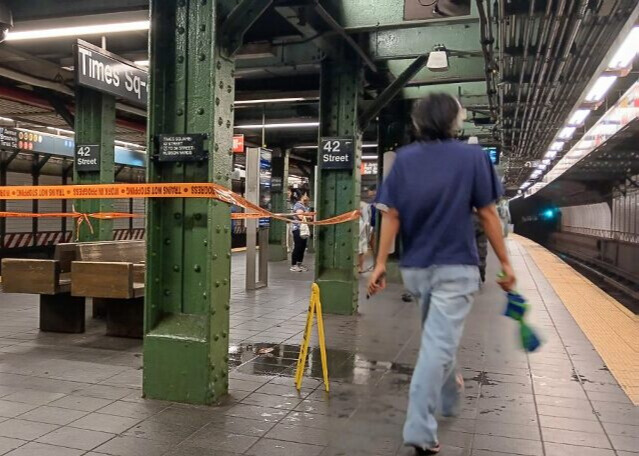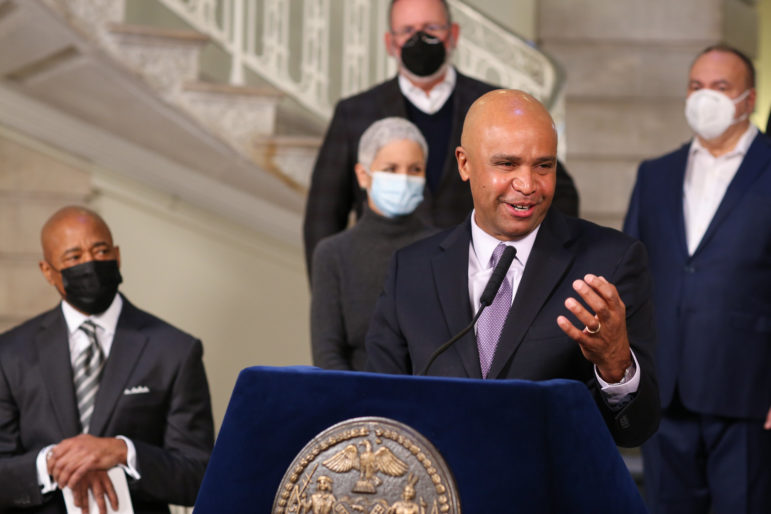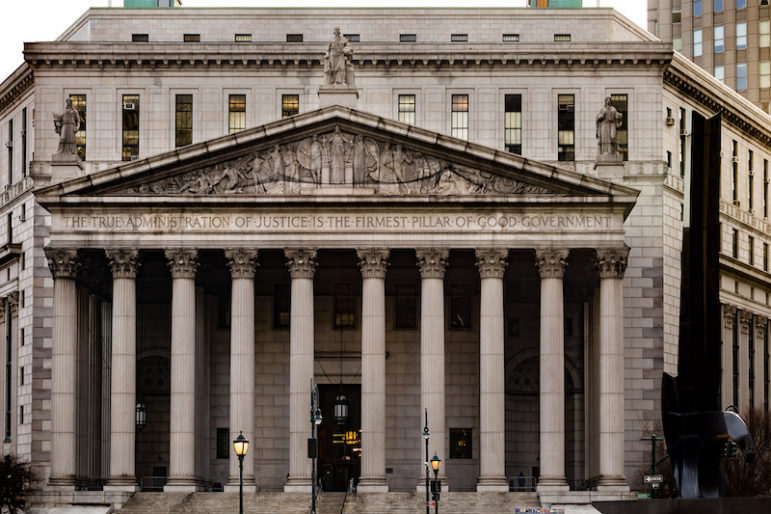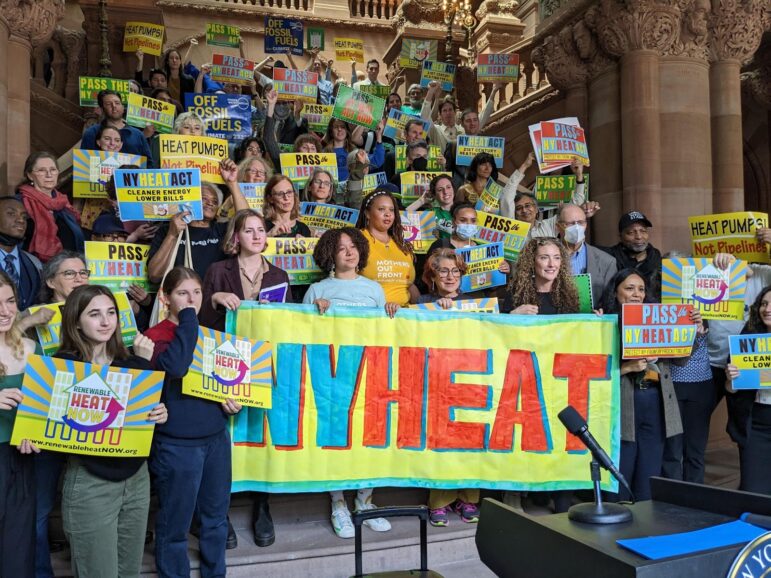New Yorkers are taking notice as the city’s aging subway system battles with more downpours and the threat of Sandy-like floods.

Emmanuel Brown
A wet subway station floor taped off on a recent rainy day at the Times Square station.This story was produced by student reporters in City Limits’ CLARIFY News program, with instruction and editing by Julian Roberts-Grmela.
New York City’s aging transit system is up against increasingly heavy rainfall and flooding, crippling commutes and exposing serious vulnerabilities to future climate disasters.
Commuters like 23-year-old retail worker Georgie Hernandez have experienced these vulnerabilities firsthand.
“Not that long ago at 157th Street, which is usually one of the stops that I frequent on the 1 train, the whole station got flooded,” said Hernandez. “I had to evacuate the subway because of how much water was going into the station; it overfilled up to the staircase, so it was pretty difficult for people to get in and out of trains.”
Flooding like this has garnered more attention recently. Earlier this month, multiple days of heavy rainfall, followed by the remnants of Hurricane Debby, led to flash flooding across the city. And just this past weekend, more wet weather sent water pouring into some subway stations, forcing riders to wade through or hop over puddles, according to social media posts.
New Yorkers get to check "flooded subways" off our bingo cards as @GovKathyHochul heads to the DNC to gaslight voters on a national stage after defunding MTA by $15,000,000,000. pic.twitter.com/eFiJTszpFj
— 🚇 Riders Alliance (@RidersAlliance) August 19, 2024
Such incidents come despite efforts to bolster the transit system’s resilience, including test rollouts of flood prevention measures such as Flex-Gates, which are carbon-fiber tarps that cover subway entrances, and thick metal doors that can create a watertight seal.
After Hurricanes Sandy and Ida, which caused $5 billion and $128 million in damage to MTA infrastructure respectively, the agency released its Climate Resilience Roadmap in April, outlining a $6 billion investment plan over the next decade.
It sets out 10 core goals to tackle climate-related risks to MTA infrastructure, with specific actions planned for the short term (within five years) and long term (beyond five years), along with cost estimates for each initiative. This includes elevating critical structures above expected flood levels, installing advanced drainage and pumping systems, and enhancing city programs aimed at bolstering climate resilience.
Additionally, the MTA has plans to finish installing Flex-Gates by 2026. These gates, produced by ILC Dover, were first installed to prevent flooding in stations after Sandy.
While the MTA makes efforts to fix the problem, customers remain dissatisfied. Gregory Peymedo, a 27-year-old customer service representative, believes that the MTA’s attempts to handle flooding have been lackluster.
“They [have been] doing all this work consistently over the years, and [then when] we have a few inches of rain, the whole thing is flooded,” said Peymedo.
Harsh weather will only be more frequent in the future. A team at MIT used its compound flood-modeling method to predict climate change’s influence in New York City through hurricanes. They found that currently, hurricanes of Sandy’s magnitude have a likelihood to hit New York every 150 years, but that rate will only increase. By mid-century, those hurricanes will have a likelihood to hit every 60 years; by the end of the century, they will have a likelihood to hit every 30 years.
Advocacy groups such as Riders Alliance, which fights for public transportation improvements, believes that the city has a role to play, too, and must act fast.
“[Mayor Eric Adams] needs to move heaven and earth to add bus shelters to protect riders from harsh weather conditions while we wait aboveground,” said Danny Pearlstein, the communications director at Riders Alliance. “While the city has helped reduce subway flooding in some areas, City Hall needs to do much more to help the transit system adapt to climate change.”
Work on flooding prevention will only become harder after the pause of congestion pricing. The plan, which has now been delayed indefinitely by Gov. Kathy Hochul, was supposed to raise around $1 billion a year for the MTA, money crucial for all future projects.
According to the MTA, all projects are planned to go ahead as if they had funding. But long-term plans won’t be known until the 2025-2029 Capital Plan is finalized in the fall.
Fanta Sanogo, a 20-year-old student who frequently uses the 145th Street subway station, reflected on a flooding incident that he encountered.
“It was just a mess. It was nasty. Water was coming down the stairs, and we were bunched up in a corner somewhere so water wouldn’t touch us,” Sanogo said. “They should find ways to prepare better for events like this.”
City Limits’ youth journalism program is generously supported by the Pinkerton Foundation, Harman Family Foundation and DJ McManus Foundation. Click here to apply for the Fall 2024 session of CLARIFY.









One thought on “With Hurricane Season Underway, Flooding Concerns Rise Among New York Commuters”
More preparations are still needed to deal with periodic major storms which result in significant disruptions to MTA bus, commuter rail and subway service. More preparations are still needed. Improve coordination with NYC Department of Environmental Protection to insure adequate storm water and sewage system capacity for all stations, tracks and tunnels. Purchase additional mobile pumps and pump trains.
Allocate more funding to bring all NYC Transit subway system pump rooms to a state of good repair, add more pump rooms and capacity. Complete all the billions in Federal Transit Adminstration Recovery and Rescilliency capital improvement projects that should have been already in place several years ago.
Insure that all NYC Transit Bus, Manhattan and Bronx Surface Transit Operating Authority Bus, MTA Bus (the former seven NYC private franchised bus operators), NYC Transit subway, Staten Island Railway, Long Island and Metro North Rail Roads yards and shops have been upgraded to deal with future flooding after heavy rain storms.
These are a higher priority than spending $7.7 billion for Second Avenue Subway Phase 2, $5.5 billion for the Brooklyn -Queens Light Rail Connector, $3.1 billion Bronx East Metro North Penn Station Access or other system expansion projects.
Five million pre COVID-19 MTA riders should not have to deal with continued inconveniences every time there is a major rain storm. Perhaps getting rid of all the elevated Manhattan subways long ago wasn’t such a good idea.
Larry Penner — transportation advocate, historian and writer who previously served as a former Director for the Federal Transit Administration Region 2 New York Office of Operations and Program Management. This included the development, review, approval and oversight for billions in capital projects and programs for NJ Transit, New York Metropolitan Transportation Authority, NYC Transit bus, subway and Staten Island Railway, Long Island and Metro North Rail Roads, MTA Bus, NYCDOT Staten Island Ferry along with 30 other transit agencies in NY & NJ.) ..